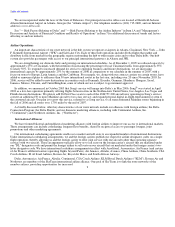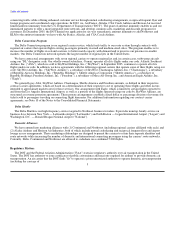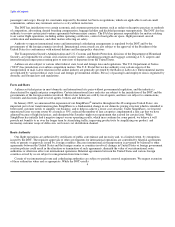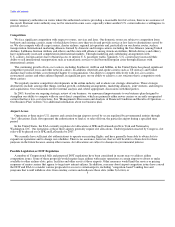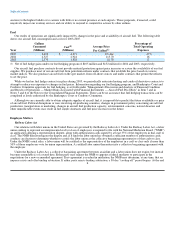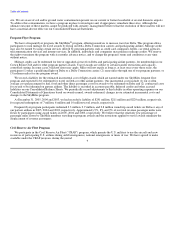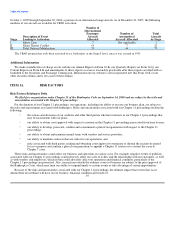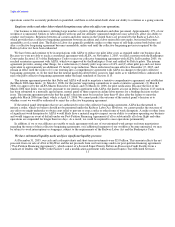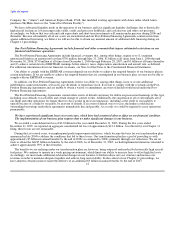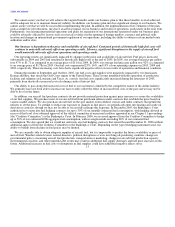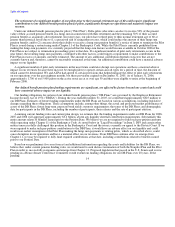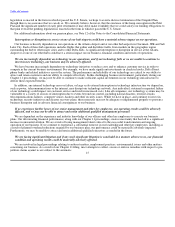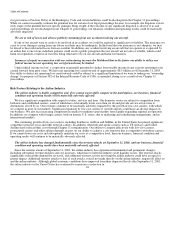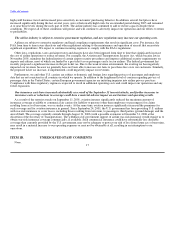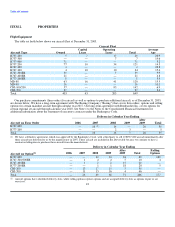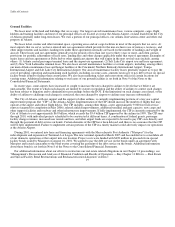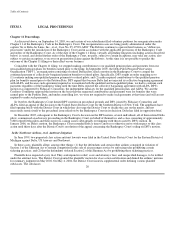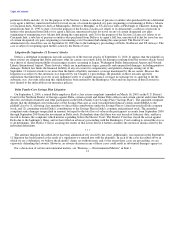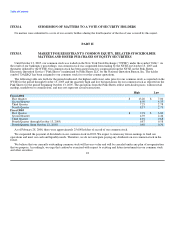Delta Airlines 2005 Annual Report Download - page 17
Download and view the complete annual report
Please find page 17 of the 2005 Delta Airlines annual report below. You can navigate through the pages in the report by either clicking on the pages listed below, or by using the keyword search tool below to find specific information within the annual report.
Table of Contents
Company, Inc. ("Amex") and American Express Bank, F.S.B. that modified existing agreements with Amex under which Amex
purchases SkyMiles from us (the "Amex Post-Petition Facility").
We have substantial liquidity needs in the operation of our business and face significant liquidity challenges due to historically
high aircraft fuel prices, low passenger mile yields, credit card processor holdbacks and cash reserves and other cost pressures.
Accordingly, we believe that our cash and cash equivalents and short-term investments will remain under pressure during 2006 and
thereafter. Because substantially all of our assets are encumbered and our Post-Petition Financing Agreements contain restrictions
against additional borrowing, we believe we will not be able to obtain any material amount of additional debt financing during our
Chapter 11 proceedings.
Our Post-Petition Financing Agreements include financial and other covenants that impose substantial restrictions on our
financial and business operations.
The Post-Petition Financing Agreements include financial covenants that, among other things, require us to (1) maintain
unrestricted funds in an amount not less than $750 million through May 31, 2006; $1 billion at all times from June 1, 2006 through
November 30, 2006; $750 million at all times from December 1, 2006 through February 28, 2007; and $1 billion at all times thereafter
and (2) achieve certain levels of EBITDAR (earnings before interest, taxes, depreciation, amortization and aircraft rent, as defined).
For additional information about our financial covenants, see Note 8 of the Notes to the Consolidated Financial Statements.
Our ability to comply with the EBITDAR covenant depends on our ability to achieve the targeted benefits of our business plan in
certain timeframes. If we are unable to achieve the targeted benefits that are contemplated in our business plan, we may not be able to
comply with our EBITDAR covenant.
In addition, our Post-Petition Financing Agreements restrict our ability to, among other things, incur or secure additional
indebtedness, make investments, sell assets, pay dividends or repurchase stock. If we fail to comply with the covenants in the Post-
Petition Financing Agreements and are unable to obtain a waiver or amendment, an event of default would result under the Post-
Petition Financing Agreements.
The Post-Petition Financing Agreements contain other events of default customary for debtor-in-possession financings of this type,
including cross defaults to each other and certain change of control events. Additionally, the suspension of all or substantially all of
our flight and other operations for longer than two days would, in most circumstances, including as the result of our inability to
operate because of a strike by our pilots, be an event of default. If an event of default were to occur, the lenders could declare
outstanding borrowings under these agreements immediately due and payable. As a result, we could be required to cease operations
permanently.
We have experienced significant losses in recent years, which have had a material adverse effect on our financial condition.
The implementation of our business plan requires that we make significant changes to our business.
We recorded a consolidated net loss of $3.8 billion for the year ended December 31, 2005. During the five years ended
December 31, 2005, we reported an aggregate consolidated net loss of approximately $12.3 billion. As reflected by our Chapter 11
filing, these losses are not sustainable.
During the last several years, we implemented profit improvement initiatives, which became the basis for our transformation plan
announced in late 2004 to address the conditions that led to these losses. Our transformation plan has a goal of providing us with
approximately $5 billion in annual benefits by the end of 2006 (as compared to 2002), primarily through cost reductions. We are on
track to obtain the full $5 billion in benefits by the end of 2006. As of December 31, 2005, we had implemented initiatives intended to
achieve approximately 90% of these benefits.
The benefits we are realizing under our transformation plan are, however, being outpaced and masked by historically high aircraft
fuel prices. We continue to operate in a weak pricing environment, which limits our ability to increase fares to offset high fuel costs.
Accordingly, we must make additional substantial changes in our business to further reduce our cost structure and increase our
revenues in order to maintain adequate liquidity and achieve long-term viability. In the context of our Chapter 11 proceedings, we
have adopted a business plan to target the delivery of an additional $3 billion in annual benefits by the end of 2007.
12


